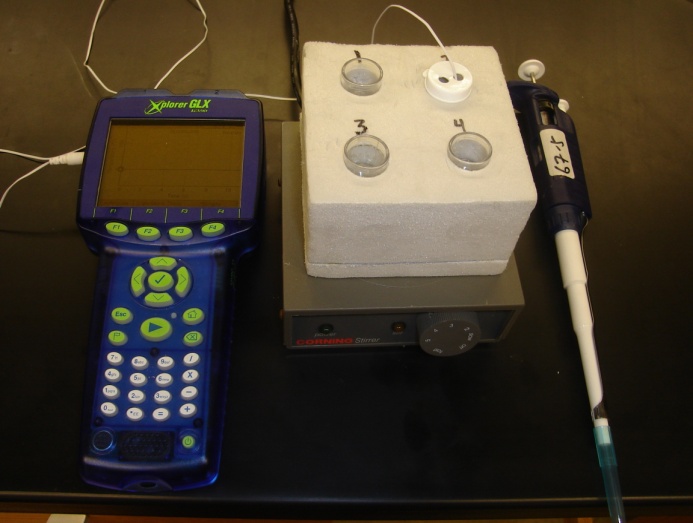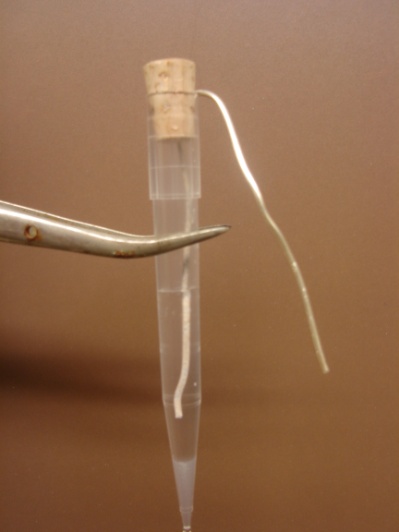Rebecca Barlag, Lauren Mcmills, Frazier Nyasulu
Chemistry and Biochemistry, Ohio University, Athens, OH 45701
Correspondence to: Rebecca Barlag, Chemistry and Biochemistry, Ohio University, Athens, OH 45701.
| Email: |  |
Copyright © 2012 Scientific & Academic Publishing. All Rights Reserved.
Abstract
In 2008, we purchased modern laboratory equipment (dataloggers, sensors and autopipettors) and began an ongoing overhaul of our entry-level chemistry laboratory program. Our goal was to take advantage of the superior sensitivity and automated data recording and analysis afforded by the new equipment, to improve pedagogy and to save time and money. We share some of our experiences in this communication.
Keywords:
General Chemistry, Lab Instruction, Dataloggers, Lab Equipment
Cite this paper: Rebecca Barlag, Lauren Mcmills, Frazier Nyasulu, Upgrading General Chemistry Laboratory Equipment and Laboratory Procedures for Improved Efficiencies and Savings, Journal of Laboratory Chemical Education, Vol. 2 No. 2, 2014, pp. 15-17. doi: 10.5923/j.jlce.20140202.02.
1. Introduction
Large enrollment entry-level laboratories are very expensive to run. Careful consideration of the types and amounts of reagents used and how these reagents are made, stored and delivered, can lead to major savings. Labs should accomplish the desired pedagogy safely and quickly, and be based on the best practices available with the equipment at hand. Large institutions have lab technicians to manage operations. The cost of lab personnel is, in many cases, a significant portion of the entry-level budget. Making changes in the experiments and in the way the lab technicians perform their work can save money.We offer five different entry-level courses with 1400-1800 students enrolled per semester. Students in each of these courses are split into sections of ~24 students, each of them with their own teaching assistant, which meet at one of twelve different times throughout the week (72 lab sections per week). At any given time, we can have up to seven laboratory rooms in use with any combination of our courses running simultaneously. We share some of our experiences in this communication. Modern Equipment: Modern equipment (dataloggers, datalogger sensors, autopipettors) can reduce student procedure times by half and reduce reagent volume and or concentrations up to five-fold. As an example, consider the determination of the enthalpy of neutralization, a common general chemistry lab exercise. Using small temperature sensors with a sensitivity of ± 0.01℃ and using the autopipettor, it is now possible to perform enthalpy determinations using total volumes of only 2-3 mL compared to 20-30 mL previously. The setup is shown in Figure 1.  | Figure 1. Setup for micro-calorimetry |
Shelving Space: We were able to install removable shelving in each of our labs without compromising the workspace and safety of our students. The shelving is used to store equipment as well as routine substances that do not have special storage requirements (buffer standards, NaHCO3 etc). The equipment used on a routine basis is stored in plastic boxes, which are stored on shelves. Our students work in pairs and each pair of students is assigned an equipment box for the entire semester, allowing us to keep track of how well each group takes care of the equipment. This has led to better student care of the equipment. Specialized equipment that is not used routinely such as pH sensors, conductivity sensors and the calorimeter are also stored on the shelves. Our lab technician no longer has to move equipment in and out of labs as was necessary before the installation of the shelves.Major Solutions Prepared Once a Year: We prepare HCl(aq), NaOH(aq), HC2H3O2(aq), H3PO4(aq) and NH3(aq) solutions once a year and store them in 5 L, 10 L and 20 L carboys. These solutions are stored in a centrally located room so that teaching assistants can replenish whatever solutions they need. We no longer require a lab technician to be present during all lab times, reducing overtime costs.Provide Solutions in Re-sealable Containers: We provide most solutions to students in small re-sealable plastic containers (20-50 mL) so that they can be reused by others. The volume in each re-sealable container is ~30% higher than needed for the entire week of lab so that refilling is not ordinarily necessary. Students use autopipettors to access the solutions in the plastic containers, and with new pipet tips being used each time we have not experienced any major contamination problems. Students are required to report any accidental contaminations; no penalty is assessed for accidental contaminations. For buret titrations, we provide solutions in wash bottles; the wash bottle tip is cut off to allow higher flow rates. It is faster, easier and safer to fill a buret using a wash bottle compared to using a beaker and funnel. By also providing caps for the wash bottles, the wash bottles are re-sealed for use by other students. Previously, students would use small beakers to obtain reagents and to avoid contamination issues and any unused solution was discarded. These approaches have decreased our overall reagent cost three-fold. For a potentiometry exercise, the reference electrode, the Eo half-cells and the concentration half-cells are housed in autopipettor tips containing agarose with pre-dissolved KNO3. A sample Eo half-cell is shown in Figure 2. Solutions in potentiometry exercises typically contain heavy metals. Using our approach the total volumes of these solutions have been reduced 20-fold. | Figure 2. Silver Eo half-cell |
Students Prepare Many of the Solutions Needed: We require students to prepare many of the solutions they need. By using a mass-based approach, volumes prepared are matched to the needs of the experiment. In mass-based solution preparations, the mass of solute is added to a small beaker and water is added to reach a target total mass (typically 10-15 g). [1] If the concentration in mol/L is desired, the density of the solution is determined by weighing 1.00 mL aliquots. As has been documented in the literature, students do not know how to prepare solutions unless they are given many opportunities to do so. [2,3] The lab technician’s work in this case is greatly simplified; all that is required is the provision of solid reagents in re-sealable containers. Automatic Data Recording and Data Analysis: As an example, consider the determination of absolute zero where pressure (fixed volume metal sphere) is measured as a function of temperature. With modern equipment, the sphere can be placed in hot water, removed from the hot water and the temperature and pressure measured at preset intervals as the sphere cools. The equipment also has the ability to provide an equation of the line from plots of the pressure versus temperature. This approach provides absolute zero as 273 ±5℃, a range we consider sufficient for entry-level chemistry purposes. It avoids expensive temperature baths, expensive lab technician time and requires only 20 minutes for students to complete. Concentration Standards Made By Adding Aliquots of Concentrated Stock Solutions: There are many labs in which the effect of concentration is investigated. For measurements in which the sample is not consumed, the concentration can be varied by sequentially adding aliquots (0.10 mL to 1.00 mL) of a concentrated standard to a known starting volume of solvent or solution. For example, for the determination of Ka of a weak acid, aliquots of a weak acid and conjugate base can be added to de-ionized water in a test-tube, which already holds a pH electrode. [4] Another example where this method has made a major improvement is in the construction of an absorbance calibration line. Instead of making a number of different solutions and making the absorbance measurements one after another, absorbance measurements are made after the addition of aliquots of a concentrated standard to a starting blank solution. [5] When large variations in concentrations are desired, aliquots from much higher concentrated standards can be added. Students can complete these procedures two times faster than classical approaches. Therefore these procedures save both time and money.
2. Conclusions
With these changes, the lab personnel hours have been reduced by 50% and reagent and waste costs have been reduced by five-fold. In the first four years of operation, the total savings exceeded the $90,000 we invested in purchasing the equipment and storage containers.
References
| [1] | McMills, L.; Nyasulu, F.; Barlag, R., J. Chem. Educ. 2012, 89, 958-959. |
| [2] | Quigley, M. N., J. Chem. Educ. 1991, 68, 505 - 508. |
| [3] | Dunnivant, F. M.; Simon, D. M.; Wilson, S., Chemical Educator, 2002, 7, 207 – 210. |
| [4] | Nyasulu, F.; Moehring, M.: Arthasery, P.; Barlag, R., J. J. Chem. Educ. 2011, 88, 640-642. |
| [5] | Nyasulu, F.; Barlag, R., J. J. Chem. Educ. 2011, 88, 313-314. |



 Abstract
Abstract Reference
Reference Full-Text PDF
Full-Text PDF Full-text HTML
Full-text HTML